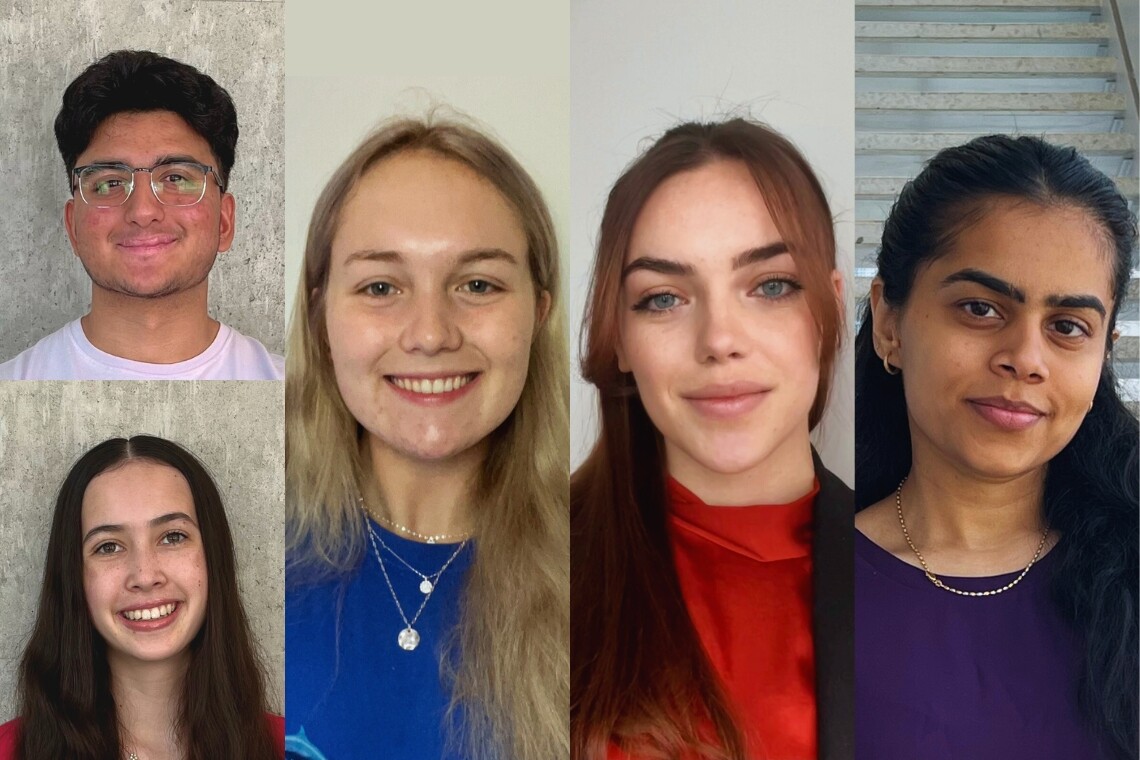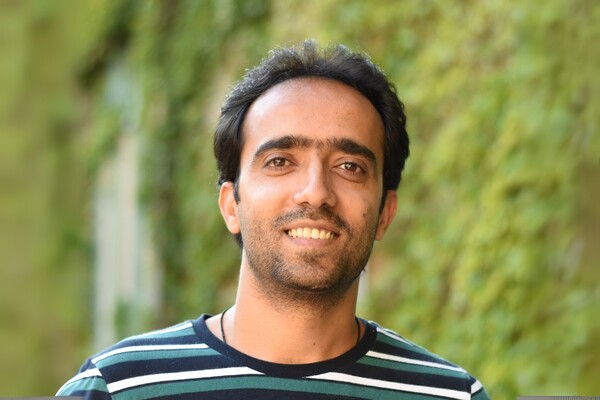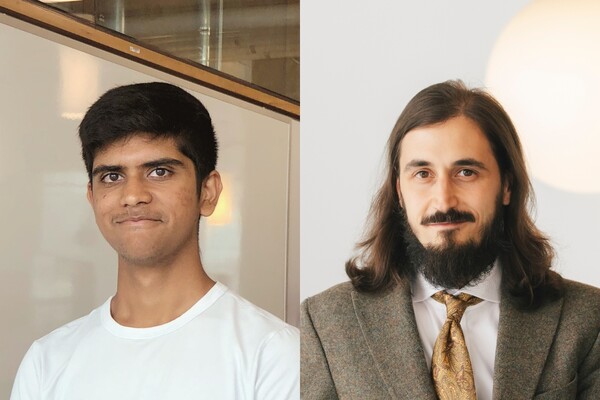Main Second Level Navigation
Summer undergraduate students advance research on opioid addiction, osteoporosis, eye disease and inflammation

The Donnelly Centre for Cellular and Biomolecular Research welcomes a new cohort of undergraduate students each summer, where experience in a lab environment and mentorship by trainees and faculty help prepare them for a future in biomedical research.
This summer, the Donnelly Centre relaunched and expanded its Summer Undergraduate Research Program, hosting around 40 students between May and August, including international students from the King Abdullah University of Science and Technology in Saudi Arabia.
The 2024 program consisted of faculty seminars exclusive to summer undergraduates, as well as career discussions with trainees and an assistant professor. The program culminated in a symposium, where undergraduate students shared their summer projects at a research talk competition and poster session and attended a networking reception and a career panel exploring options outside of academia.
"We are proud to have a history of fostering undergraduate talent at the Donnelly Centre," said Stéphane Angers, director of the Donnelly Centre. "We prepare our summer students to have successful careers, whether it be in research or another industry, by exposing them to a wide range of mentors and research questions that the Donnelly Centre is working towards solving. We aim to inspire and train the next generation of leaders in health and medicine."
Undergraduate students join labs at the Donnelly Centre full-time for all or a portion of the summer semester, taking on highly involved roles in research projects.
We are highlighting five undergraduate students who spent the last few months getting a taste of what life is like at the Donnelly Centre.
Understanding opioid addiction development
Taha Malik is entering the fourth year of his undergraduate program, pursuing a double major in molecular genetics and pharmacology. Charlotte Selda is entering the second year of her undergraduate program, pursuing a specialist in laboratory medicine and pathobiology, a major in biochemistry and a minor in immunology. Both students spent their summer working for Derek van der Kooy, professor of molecular genetics.
While Selda is in the early stage of her undergraduate career, she knew she was interested in trying her hand at research from her experience in first-year lab courses. This summer was meant to be a test drive to determine if Selda would want to pursue research after graduating.
Malik, on the other hand, has been a member of the van der Kooy lab since September 2023. He is making use of the summer semester to wrap up long-term projects.
“A big part of the Summer Undergraduate Research Program is early exposure,” said Selda. “A lot of students don’t know what careers are out there. I joined the program because I thought that one of the most important things I could do right now is see if I’m interested in research – which I am.”
Malik and Selda worked together over the summer to better understand the opioid reward pathway in mice. There are two pathways through which mice, and humans, can experience opioids: the naïve pathway, which represents first-time exposure, and the dependent pathway, where the subject has been previously exposed to the opioid.
While the dependent pathway has been studied to a certain degree, the naïve pathway lacks the same level of study. Malik and Selda aimed to improve characterization of the naïve pathway through optogenetics.
The students activated neurons in certain patterns to imitate the activation of the drug reward pathway in subjects. This experiment was meant to determine if imitating opioid neuron firing patterns is necessary to initiate a particular stage of the reward pathway, or if any type of stimulation is enough to do this. Malik and Selda found the former to be the case.
Their research contributes to improving researchers’ understanding of how opioid addiction develops at the molecular level and how the reward pathway works when the threat of withdrawal symptoms is removed from the equation. The naïve pathway differs from the dependent pathway in that the positive reinforcement that leads to addiction is not compounded by the negative reinforcement of avoiding withdrawal symptoms.
Selda will continue to pursue research opportunities to develop new skills, and is open to returning to the Donnelly Centre, noting that her first research experience in the van der Kooy lab had been a positive one.
Malik will join a lab at the Leslie Dan Faculty of Pharmacy for a thesis project in optogenetics and pain. He hopes to pursue a Doctor of Medicine in psychiatry to implement his learnings from conducting basic research to translational therapy.
“My goal is always to get more experience, including with failing,” said Malik. “I’m going to keep myself busy this academic year with my thesis project. Hopefully I will get more experience with failing through this project, since it’s an inevitable part of science, so I can get a grasp on it for the future.”
Regenerating bone tissue to treat osteoporosis
Alexa Maxwell is entering the third year of her undergraduate program at McGill University, majoring in biology and minoring in biotechnology. She conducted a summer research project under the supervision of Stéphane Angers, professor of biochemistry and pharmaceutical sciences.
Maxwell chose to spend her summer conducting research at the Donnelly Centre to stay productive and keep her mind stimulated during what would typically be a break in the academic year. She anticipated that gaining wet lab experience, where she would be responsible for live cells or specimens, would be a particularly rewarding use of the summer semester.
The University of Toronto was Maxwell’s first choice for summer research experience, as she would be returning to Toronto, her hometown, for the semester. She was also drawn to U of T’s reputation for innovative research, training in the biomedical sciences and network of hospital partners.
As a member of the Angers lab, Maxwell got involved with research on the Wnt signaling pathway, which regulates cell communication and impacts cell development and movement. She used antibodies developed by the lab to activate the Wnt pathway in bone cells.
The goal of Maxwell’s research project was to determine the concentration of antibodies required to stimulate bone regeneration for treating osteoporosis. Focusing on two types of bone cells, osteoblasts and osteocytes, Maxwell experimented with antibody dosage to find the best receptors to target for bone regeneration.
Near the end of the summer semester, one of the final steps of the research project was to conduct an osteogenesis assay to confirm that the osteoblast cells Maxwell had been working with were developing into bone tissue.
Maxwell describes her experience working at the Donnelly Centre as highly valuable, given how much she learned over a short period. The experience gave her the confidence to continue pursuing her undergraduate degree in science by preparing her for more advanced upper-year courses.
In particular, she developed skills in independent learning, collaboration, critical thinking and time management. Maxwell believes that these skills are more effectively developed and strengthened in a laboratory environment that fosters experimentation than in a lecture hall.
Maxwell is open to returning to U of T for another summer research experience in the future, in the hopes of refining her career plans. She will decide between applying to medical school and graduate school by this time next year.
“I wanted to be prepared for a six-hour lab class I’ll be taking in the Fall,” said Maxwell. “I thought the Donnelly Centre’s Summer Undergraduate Research Program would give me a head start. This experience gave me the opportunity to see what it’s like to work with other people in a lab. I was worried that research would be lonely, but it’s really collaborative.”
Testing a treatment for degenerative eye disease
Ellie Monroe is entering the fourth year of her undergraduate program, pursuing a neuroscience specialist, pharmacology major and physiology minor. She is conducting research under the supervision of Molly Shoichet, university professor of chemical engineering and applied chemistry.
Monroe has been a member of the Shoichet lab since last summer, continuing to conduct research in the lab throughout the academic year for her thesis project.
This summer, she worked on a research project to understand the mechanism of rod-derived cone viability factor (RdCVF) in human retinal organoids, for the overarching aim of preventing degeneration of cone photoreceptors that are responsible for high-acuity vision. This project builds on previous research that focused on mechanistic studies of RdCVF in rats and chicks.
“I have been able to explore and discover my passion for regenerative medicine while working in the Shoichet lab thanks to my mentor, Lia Huo,” said Monroe. “This lab has created a very supportive environment that fostered my creativity. The enthusiasm that has been infused into this project and Lia’s mentorship were a big part of my decision to continue working in the Shoichet lab.”
Monroe was connected to Huo through a postdoctoral fellow currently in the Shoichet lab who is an alum of Thompson Rivers University, from where Monroe transferred to U of T.
Monroe decided to move to Toronto and continue her academic career at U of T because of the opportunities both the university and the city offer. Although it was a big change from the smaller campus of Thompson Rivers University, Monroe welcomed the challenge and was excited by the possibilities of what she could accomplish at U of T.
Nearly a year-and-a-half since joining the Shoichet lab, Monroe is now growing retinal organoids to test the mechanism of RdCVF in human cells. She is culturing the organoids from both healthy and diseased cells to study how these states alter interactions with important molecules, including RdCVF.
While RdCVF delivery showed promise in animal models, it has not yet been tested on human cells. The protein promotes cone photoreceptor survival by increasing the uptake of glucose – an important source of energy for cells.
Monroe’s summer research aims to inform the development of treatments for degenerative eye disorders – specifically retinitis pigmentosa, which affects 1.5 million people worldwide.
She cites her undergraduate experience as a unique one, in that it has lasted longer than the typical four-year program due to transferring universities. She believes that this journey has taught her the importance of being attentive and maintaining imagination to make the most out of the highly influential and developmental years that take place over an undergraduate degree.
Monroe plans to pursue a career in medicine and neuroscience research, with a focus on neurodegenerative disease and traumatic brain injury.
Identifying proteins for inflammation treatment
Tisha Parikh is a recent graduate of the life sciences program at McMaster University. She conducted research at the Donnelly Centre under the supervision of Mikko Taipale, associate professor of molecular genetics.
Parikh has an established history with the Donnelly Centre, having worked in the lab of Brenda Andrews, university professor of molecular genetics, and Charles Boone, professor of molecular genetics, over the summer semester in 2022.
The following summer, Parikh had her first experience working in the Taipale lab, where she conducted research on using induced proximity methods to explore novel protein interactions and design molecules optimized for drug therapy.
This summer, Parikh split her time between working for McMaster Children’s Hospital and the Donnelly Centre. She has been pursuing summer research positions at the Donnelly Centre over the last three years to gain hands-on lab experience, which she would not otherwise have. Her lab experience complements the detail-oriented administrative work she does for the hospital.
Parikh chose to continue working in the Taipale lab for a second summer, this time to study effector proteins of immune signaling pathways. She spent her summer analyzing the results from a screen, where many of the effector proteins found were previously unknown to science. Conducting this project helped Parikh see how the immune signaling pathway functions at the cellular level.
Effectors identified from the screen were found to reduce the severity of immune responses and were confirmed to behave similarly to known effector proteins. This means the previously unknown effectors have potential uses in drug development to treat symptoms of overactive immune systems, such as inflammation.
Having spent two summers working the Taipale lab, Parikh was able to dip her toes into its two major areas of focus: effector proteins and induced proximity. Members of the lab are working to integrate these two research topics by applying their findings from each one to the other.
Parikh’s time at the Donnelly Centre allowed her to learn about and explore some of the most promising areas of drug discovery research. She plans to take the skills she developed in the labs with her to medical school. Parikh believes that the research she conducted at the Donnelly Centre research will help shape tools for researchers in medicine and health that will ultimately benefit everyone.
“Before joining labs at the Donnelly Centre, most of my research experience was limited to the clinical side of things,” said Parikh. “I wanted to see what I learned in class in real life and get hands-on experience, so I sought out in-person lab positions where I would be responsible for my own experiments. I learned that there’s a huge breadth of options for where you can take things in basic research.”
News



